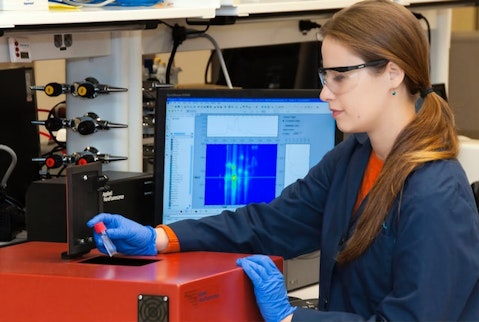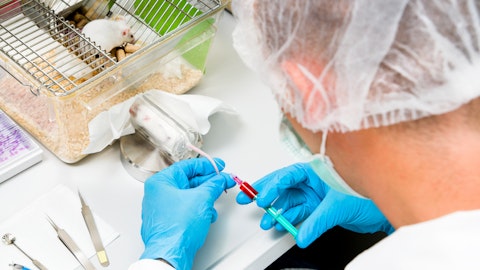Selecta Biosciences, Inc. (NASDAQ:SELB) Q4 2022 Earnings Call Transcript March 2, 2023
Operator: Good morning, and welcome to the Selecta Bio Fourth Quarter 2022 Earnings Release Conference Call. Please note this event is being recorded. I would now like to turn the conference over to Blaine Davis, Chief Financial Officer. Please go ahead.
Blaine Davis: Thank you, and good morning, everyone. Welcome to our fourth quarter and full year 2022 Financial Results and Business Update Conference Call. The press release reporting our financial results is available in the Investors and Media section of Selecta’s website at www.selectabio.com in our Annual Report on Form 10-K for the year ended December 31, 2022, which was filed earlier this morning with the Securities and Exchange Commission or the SEC. Joining me on today’s call are Carsten Brunn, President and Chief Executive Officer; Kei Kishimoto, Chief Scientific Officer; and Peter Traber, our Chief Medical Officer. During today’s call, we will be making certain forward-looking statements, including, without limitation, statements about the potential safety, efficacy and regulatory and clinical progress of our product candidates, our financial projections and our future expectations, plans, partnerships and prospects.
These statements are subject to various risks that are described in the filings made with the SEC, including our most recent Annual Report on Form 10-K and subsequent quarterly reports on Form 10-Q. You are cautioned not to place undue reliance on these forward-looking statements, which speak only as of today, March 2, 2023, and Selecta disclaims any obligation to update such statements, except as required by law, even if management’s views change. With that, I’d now like to turn the call over to Carsten.
Carsten Brunn: Thank you, Blaine. Good morning. I appreciate everyone taking the time to join us today. In the fourth quarter of 2022 and in the first months of 2023, we continue to make steady progress across our pipeline, and we believe we’re well-positioned to execute on our key priorities and reach multi milestones throughout this year. In collaboration with our partner, Sobi, we expect to announce top line data from the Phase III DISSOLVE I and II clinical trials of SEL-212 later this quarter. We remain blinded to the data based on the results from previous trials in which we observed SEL-212’s differentiated profile and convenient once-monthly dosing regimen, we remain confident in its potential to improve the lives of patients suffering from chronic refractory gout.
Further, we plan to continue to leverage our growing safety database to advance our ImmTOR clinical development programs for our ongoing ReiMMAgine Phase I/II clinical trial of SEL-302 for the treatment of methylmalonic acidemia, or MMA, and propel our next-generation programs forward. Notably, we recently identified an Interleukin-2 or IL-2 candidate to be started in combination with ImmTOR in a broad set of potential autoimmune indications as well as an IgA protease candidate for the treatment of IgA Nephropathy. We also continue to accelerate our IgG Protease called Xork following a deal we signed with Astellas in early January, which involves the study of Xork in combination with AT845 an investigational adeno-associated virus or AAV-based treatment for Late-Onset Pompe Disease.
As we look ahead, we intend to continue to advance our pipeline in autoimmune disease and explore additional collaborations to maximize the value of our ImmTOR platform and pipeline. On the cusp of this pivotal moment in the company’s growth trajectory, we’d like to provide an update on recent activities and share details on how these programs align with our mission to solve the toughest challenges associated with unwanted immunogenicity. The current standards of care for autoimmune disease utilize immunosuppressive drugs or symptom-masking treatment. Unfortunately, these treatments often leave patients vulnerable to serious infections, malignancies and fail to adequately address the underlying cause of the disease, which is an imbalance of regulatory T-cells versus effective T-cells.
At Selecta, we’re reimagining immunotherapy. There are over 24 million Americans still suffering from autoimmune diseases. We believe ImmTOR has the potential to transform the treatment landscape by restoring natural immune system balance through induction and expansion of regulatory T-cells in vivo. The combination of ImmTOR and IL-2, which we call ImmTOR-IL represents an evolution of Selecta’s precision immune tolerance platform that has the potential to further enhance the magnitude and duration of immune tolerance in patients treated for autoimmune diseases. We have chosen IL-2 development candidate that will be started in combination with ImmTOR to potentially further advance and expand our pipeline in autoimmune disease. We plan to initiate I enabling studies in 2023 while also exploring multiple autoimmune indications that may be suitable for study with ImmTOR-IL with an initial focus on diseases of the liver.
We believe ImmTOR-IL has the potential to be a truly differentiated first-in-class treatment for those suffering from autoimmune diseases. We plan to initiate multiple preclinical studies this year with this exciting combination. Moving on to our gene therapy vertical, which we believe has the potential to enhance the efficacy and safety of AAV gene therapy and broaden patient population for such therapy. ImmTOR is designed to enable patients to receive multiple lower doses of AAV gene therapy, titrate up to a therapeutic benefit and mitigate side effects associated with higher vector doses, thereby transforming the dosing paradigm from one-and-done to a low-and-slow. In December 22, we initiated ReiMMAgine, the Phase I/II clinical trial of SEL-302, an AAV gene therapy combined with ImmTOR for the treatment of MMA.
The ReiMMAgine trial is now enrolling patients and aims to evaluate the safety, tolerability and efficacy of SEL-302. ReiMMAgine builds on our human proof-of-concept study in healthy volunteers, where we observed that with a single dose of ImmTOR at 0.3 mg/kg, all subjects maintained utilizing antibodies or Nab titers below 1:25 at Day 30 and two-thirds of the subjects at this dose of ImmTOR maintained Nab titers below 1:5 at Day 30. We believe our preclinical data in nonhuman primates and mice indicate that two additional monthly doses of ImmTOR have the potential to provide durable inhibition of anti-AAV Nabs. We’ve incorporated this dosing regimen in the ReiMMAgine trial. By advancing SEL-302 into the clinic, we believe we can help our current and future gene therapy partners accelerate the use of ImmTOR in their gene therapy programs by providing a clinical and regulatory blueprint to follow.

Photo by National Cancer Institute on Unsplash
In January 2023, we announced an exclusive licensing and development agreement for Xork to be developed for the use with AT845, Astellas investigational AAV-based treatment for Late-Onset Pompe Disease in adults. Xork a next-generation IgG protease. Most other IgG protease in development are derived from common human pathogens and as a result there is a high prevalence of pre-existing antibodies against these proteases that can restrict their utility. Xork is differentiated by its low cross reactivity to pre-existing antibodies in human serum, and we believe it has the potential to deliver transformative gene therapy treatments to a broader range of patients living with debilitating diseases. Many patients are currently ineligible for clinical trials with investigational AAV gene therapies due to the presence of naturally occurring antibodies against AAV capsids.
Due to its selective protease activity against anti-AAV Nabs, we believe Xork has the potential to expand access to life-changing gene therapies by addressing preexisting immunity to AAV. The objective of our gene therapy vertical is to bring hope to patients who may not have many other treatment options, enable companies to maximize the commercial potential of their gene therapy candidates and help to make otherwise uneconomic gene therapy candidates viable targets for commercial development. We plan to continue to pursue business development and out-licensing opportunities to maximize the value of our platform. Now turning to our biologics pipeline; many biologics can be highly immunogenic, resulting in suboptimal responses due to the development of antidrug antibodies after treatment.
Patients who develop an immune response may be forced to discontinue treatment or experience adverse reactions to continuous therapies. We believe the use of ImmTOR as an adjunct to biologics offers a promising approach to reduce the unwanted immune responses and improved patient outcomes. We believe our most advanced program, SEL-212, has served as clinical proof-of-concept for our ImmTOR platform with over 500 patients dosed to-date. As a reminder, SEL-212 is comprised of ImmTOR co-administered with a proprietary uricase, pegadricase for the treatment of chronic refractory gout and was licensed to Sobi in 2020. Our Phase III DISSOLVE clinical program kicked off in the third quarter of 2020 and consists of two double-blind, placebo-controlled trials of SEL-212.
In both trials, SEL-212 is being evaluated at two dose levels of ImmTOR, 0.1 mg/kg and 0.15 mg/kg with a single dose level of pegadricase at 0.2 mg/kg. We continue to work closely with our partner, Sobi, our clinical trial providers and regulatory authorities to advance towards the successful completion of the Phase III program, and we are on track to announce top line data for DISSOLVE I and II later this quarter. Based on the results from previous trials in which we’ve observed SEL-212’s differentiated profile and convenient once-monthly dosing regimen, we believe SEL-212 is well-positioned against the current standard of care and other drugs in the class that target this patient segment. In our Phase II trial, we observed a high percentage of responders in patients with both visible uric acid crystal tissue deposits, or tophi and without tophi as well as statistically significant and clinically relevant reductions in serum uric levels in treatment periods 3 and 6.
These responses were achieved with a favorable tolerability profile, simplified dosing and avoidance of immune suppression. With the promising clinical data generated to-date and SEL-212 currently in Phase III, we believe we’re well-positioned to leverage these learnings into our second biologics indication in IgA nephropathy or IgAN, a kidney disease that occurs when immune complexes of an antibody called immunoglobulin A1, or IgA1, accumulates in the kidneys. In December 2022, we selected a next-generation IgA protease from IGAN Biosciences for the treatment of IgAN and plan to initiate I-enabling studies in 2023. By combining ImmTOR with an IgA protease, we believe our novel approach has the potential to address the underlying pathophysiology of the disease by removing injurious IgA from the kidneys and improve markers of renal dysfunction.
We’re extremely excited about the advancements across our pipeline and the growing body of clinical data showcasing the promise of our ImmTOR platform in a number of applications. We look forward to continuing our momentum in the coming year. With that, I’ll turn the call over to our newly appointed Chief Financial Officer, Blaine Davis, to run through our financial results for the fourth quarter and full year. Blaine brings more than 25 years of experience in Investor Relations, Business Development, Corporate Affairs and Sales and Marketing at life science companies with a particular focus on rare diseases. Blaine’s impressive track record makes him an ideal fit for Selecta at this critical inflection point, and we’re truly delighted to have him on board.
Blaine?
Blaine Davis: Thank you, Carsten. I’m thrilled to join the Selecta team and look forward to working closely with everyone as we deliver our mission to improve the lives of our patients. Now I would like to briefly run through our financial results for the fourth quarter and full year 2022. Revenue for the fourth quarter and full year 2022 was 16.8 and $110.8 million, respectively, as compared to 29.9 and $85.1 million for the same periods in 2021. Revenue was primarily driven by the license agreement with Sobi, resulting from the shipment of clinical supply and the reimbursement of costs incurred for the Phase III DISSOLVE clinical program. Research and development expenses for the fourth quarter and full year 2022 were 19 and $72.4 million, respectively, as compared to 20.3 and $68.7 million for the same periods in 2021.
The quarterly decrease was primarily driven by a decrease in expenses incurred for the SEL-212 clinical program. The annual increase was primarily driven by expenses incurred for preclinical programs, increased personnel expense and stock compensation expense. General and administrative expenses for the fourth quarter and full year 2022 were 6.3 and $23.9 million, respectively, as compared to 5.5 and $20.9 million for the same periods in 2021. The quarterly and annual increases were primarily driven by increases in stock compensation and personnel-related expenses. For the fourth quarter and full year 2022, Selecta reported net income of $5.9 million or basic net income per share of $0.04 and net income of $35.4 million or basic net income per share of $0.24, respectively.
For the fourth quarter and full year 2021, Selecta reported net income of $12.2 million or $0.10 per share and a net loss of $25.7 million or $0.22 per share, respectively. Selecta had $136.2 million in cash, cash equivalents, marketable securities and restricted cash as of December 31, 2022 as compared to $129.4 million as of December 31, 2021. We believe our available cash, cash equivalents, restricted cash and marketable securities will be sufficient to meet our operating requirements into mid-2024. With that, I’d now like to turn the call back to Carsten for closing remarks.
Carsten Brunn: Thank you, Blaine. In 2022, we delivered on key milestones that we believe further validated the value and breadth of our innovative ImmTOR platform. We continue to advance our diversified clinical pipeline, and we established strategic collaborations that we believe can propel our next-generation programs toward multiple IND filings. We look forward to building on the momentum of our recently announced deal with Astellas for Xork and Pompe disease, the initiation of the Phase I/II trial in MMA, identification of an IL-2 candidate and selection of an IgA Protease candidate, and we remain on track to report top line data from the Phase III DISSOLVE I and II clinical trials, investigating SEL-212 in chronic refractory gout later this quarter.
We remain blind to the data, but as previously stated, are confident in SEL-212’s competitive profile and potential to treat chronic refractory gout based on the positive results from previous trials. We look forward to providing further updates in the coming weeks. Looking ahead, we remain deeply committed to solving the hardest challenges in autoimmune disease and helping patients overcome autoimmunity and unwanted immunogenicity. In parallel, we intend to continue to seek opportunities to strategically partner in our gene therapy vertical to maximize the value of our platform. Before we conclude today’s call, I would once again like to thank the entire Selecta team, our investors and the many people who have been supportive along the way, including our patients and their families.
With that, we’re happy to take questions.
See also 11 Most Profitable Energy Stocks and 10 Best Stocks to Buy for Good Returns.
Q&A Session
Follow Cartesian Therapeutics Inc.
Follow Cartesian Therapeutics Inc.
Operator: And our first question will come from Joseph Schwartz of SVB Securities.
Joseph Schwartz: I was wondering, first of all, SEL-302, if you could provide us with any more clarity on what we might expect to see from the first data readout from the study that you’re commencing? I know you’ve previously said that you expect to release data on a patient-by-patient basis. But since the first patient, I think, is being dosed without ImmTOR. I was wondering if you expect to wait until you have the first ImmTOR dosed patient as well to present this initial data set?
Carsten Brunn: Yes, that’s a great question. Yes, as we’ve previously guided, we will report interim data, so it’s three months data, looking — obviously, this is primarily a safety study, but also biomarker of the disease. And then specifically, we are interested in ImmTOR and the Nab response. So we expect to release data towards the end of this year, as you rightly said, the first patient only receives the gene therapy, the second patient then will receive ImmTOR. So we’ll likely release data towards the end of the year.
Joseph Schwartz: Okay. And then on ImmTOR-IL, I was wondering if we could get your thoughts on the recent IL-2 trial failure in SLE ? And why do you think your PBC program is perhaps better suited for success? And do you plan to report any new preclinical data across your early-stage pipeline this year?
Carsten Brunn: Yes, that’s another great question. Obviously, we haven’t looked at the data in a lot of detail. But obviously, where we think we are highly differentiated is the combination of ImmTOR with an engineered IL-2. We actually are really a first-in-class by inducing and expanding Treg-selective sales. So I think that approach — the end — specific approach is really unique and you have a much better chance of addressing the underlying disease. We are going into autoimmune diseases of the liver. And we think it’s really low-hanging fruit also because of ImmTOR accumulates in the liver. And actually, we’ve shown in a couple of models that ImmTOR alone actually already is hepatoprotective. So we’re pretty confident in the liver approach.
And yes, we will release after everybody has the eyes on DISSOLVE this quarter but after DISSOLVE readout, we’ll throughout the year, we’ll also provide more data from various animal models that Kei and his team have been working on, which are very encouraging.
Operator: The next question comes from Kristen Kluska of Cantor Fitzgerald.
Kristen Kluska: The first one to two quarter on gene therapy. So given that your partners were willing to sign deals with you ahead of MMA reading out and in some cases, even before the empty capsid data, I wanted to know how you believe that some of the MMA data and of course, your discussions with the respective regulatory agencies could further help with your conversations with current partners, but then also how it could potentially open the door for others that are interested?
Carsten Brunn: Yes, Kristen, that’s a great question. I think the fact that we signed two deals with Takeda and Sarepta, ahead of the empty capsid just shows the unmet medical need in this field. I mean there’s tremendous unmet need to prevent the formation of NAbs and give patients a chance to receive a second dose. We definitely believe that just the fact that we have empty capsid data available is an important data point. And most importantly, we have a clear regulatory path. I think that’s really important. That’s the reason we’re actually running the MMA program, and we can give clear guidance to our partners on how to develop ImmTOR and in this case, with three monthly doses of ImmTOR. And obviously, we believe that the data from the MMA study will also be helpful along the way as well.





